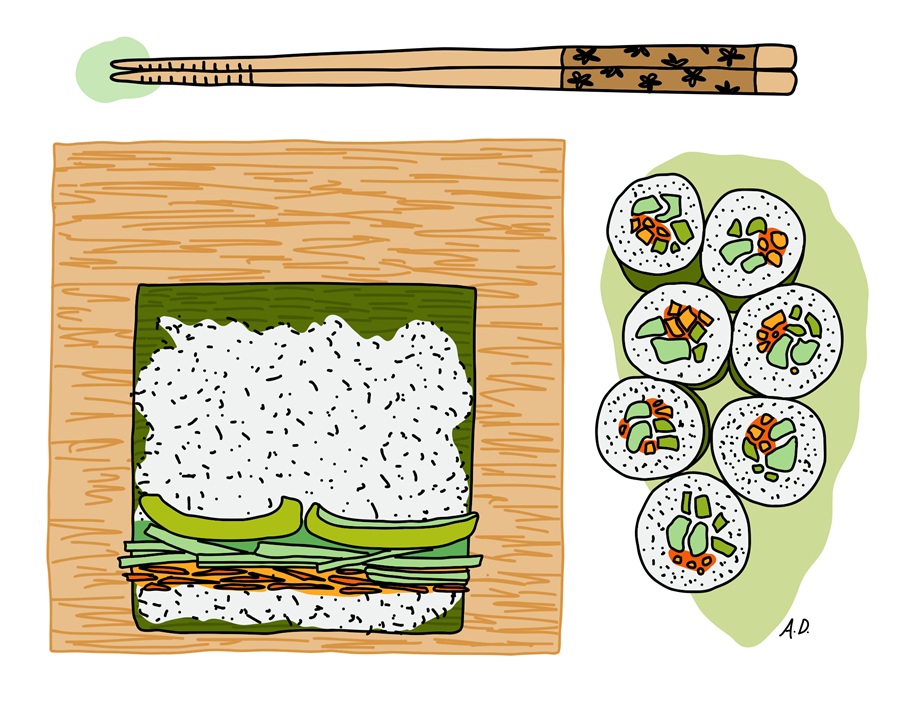My first experience of sushi was on a trip to San Francisco with my parents. We were at a sushi restaurant where would-be eaters watched the edible options go round and round on a tiny conveyor belt. I loved assessing the carefully composed little dishes as they traveled their track on display for all to see. I looked for the ones decorated with the most fascinating orange tapioca-like jelly, which turned out to be roe.
From this early moment on, I have been fascinated with sushi: the precise presentation, the composition of shapes, the colors. A sushi chef is also an artist — the ingredients a palette, the plate a canvas.

Even the plastic containers of sushi at the grocery store make an attempt at elegant presentation, with their vaguely Japanese floral patterns creating backgrounds for the evenly cut rolls, neatly spiraled pickled ginger, and dabs of wasabi that are always included.
Then there’s the eating. That part’s not so elegant until you learn to use chopsticks properly. In the most American way possible, I learned to wield my chopsticks by practicing on jellybeans. Trust me: if you can pick up jellybeans with chopsticks, sushi will be no problem. And no, I don’t spend my free time engaged in this sort of thing on a regular basis, but if you want to entertain a group of young girls at a birthday party, this is a great game. (Thanks, Mama!)
Like many offerings on our cultural smorgasbord, sushi has been appropriated into contexts beyond the Japanese sushi restaurant. Stuffed animals and card games come to mind. My favorite cultural representation comes from Wes Anderson’s 2018 film Isle of Dogs. In it, Anderson takes stop-motion animation to amazing heights, with deadpan humor and meticulously composed scenes. One of them, only about 45 seconds long, took three animators and seven months to put together. Puppet hands efficiently and masterfully make and package sushi: The fish is chopped and stacked just so; the ingredients are layered or rolled into perfect geometry. Somehow, in the magic of film, silicone is made to look like raw octopus.
What all this adds up to for me is that sushi is not just a dish; it’s a tactile process. It is meant to take time. And, if you approach it calmly, the making can be meditative and creative. Think about what color plate would complement your sushi. Try slicing the rolls on the diagonal and drizzling them with a colorful sauce. Arrange your rolls in a pattern or in neat lines. I’m telling you to do what you’ve surely been told not to: play with your food.
The ingredients for nori rolls (a type of sushi rolled in seaweed wrappers) are amazingly simple: sheets of nori, sushi rice, and assorted vegetables. My favorite combinations are included here, but there are so many good things to try. Mangoes, beets, cabbage, zucchini strips, egg omelet, and hummus (this last item may sound weird, and it’s definitely not traditional, but it’s tasty) are just a few ideas to get you going. Whatever you add, make sure it is soft or cut into thin strips or sticks.
A sushi mat can be helpful for rolling, but I do without and it’s fine. It helps if your rice is still a little warm, as the moisture will be absorbed by the nori and make it more pliable. Sushi rice is the best because it is sticky when cooked. Your rolls won’t hold together nearly as well with other kinds of rice.
Of course, you can just use a good soy sauce for dipping, but I like a homemade peanut or cashew-based sauce. A dash of rice vinegar or lime makes for a nice contrast to the mild filling. Lightly toast some black sesame seeds to sprinkle on top of the rolls for added interest and crunch.
NORI ROLLS
Makes 4 rolls or about 32 pieces
1 cup raw sushi rice (more when cooked)
2 Tbsp. rice vinegar
1 tsp. cane sugar
4 sheets toasted sushi nori
Vegetable combination #1:
1 avocado, thinly sliced
1 cucumber, deseeded and sliced into thin strips
1 carrot, sliced into thin strips on a mandoline or with a peeler
Vegetable combination #2:
1 avocado, thinly sliced
1 sweet potato, cut into half-inch strips
Vegetable combination #3:
1 cucumber, deseeded and sliced into thin strips
1 cup small sprouts
1 carrot, sliced into thin strips on a mandoline or with a peeler
½ cup shredded red cabbage
½ cup hummus
- Cook your rice according to the directions on the package. Once it is cooked, fluff with a fork and stir in the rice vinegar and cane sugar. Set aside to cool slightly while you slice your other fillings.
- If using sweet potato, cut into strips, toss lightly with oil, and roast at 425° F for 20 minutes, stirring halfway through.
- Filling and rolling: Place a sheet of nori on a clean cutting board or sushi mat. Spread a thin layer of rice over the nori, leaving a 1-inch strip bare at the far edge. If using hummus, spread on top of the rice before adding the vegetables. Top the rice with your vegetable fillings, laying them in rows one in front of the other. A strip of avocado, a strip of cucumber, etc.
- Dip your finger in water and wet the bare strip of nori. Starting at the end closest to you, tightly roll the nori over the filling. Keep rolling until you reach the end, then press down gently but firmly and leave the roll on your cutting board seam-side down while you make the rest.
- Once all your rolls are made, use a sharp knife to slice each one into 8 to 10 pieces, depending on desired thickness. Arrange rolls cut side up on a platter and sprinkle with sesame seeds. Serve with dipping sauce, wasabi, and pickled ginger.
CASHEW-LIME DIPPING SAUCE
1 Tbsp. coconut oil
1 medium white onion, diced
¾ tsp. salt
4 garlic cloves, minced
2 Tbsp. ginger, minced
1 Tbsp. mirin (rice wine)
½ cup water
1 Tbsp. tamari
¾ cup cashew butter
4 Tbsp. lime juice
- Warm coconut oil in a pan over medium heat. Add the onion and salt. Sauté until golden, then add the ginger and garlic. Sauté for another 5 minutes. Remove the pan from the heat and stir in mirin.
- Transfer sautéed mixture to a blender along with the nut butter, water, tamari, and lime juice. Blend on high speed until smooth. Add more salt and lime juice to taste.
- Serve immediately or keep in an airtight container in the refrigerator for up to 3 days.



